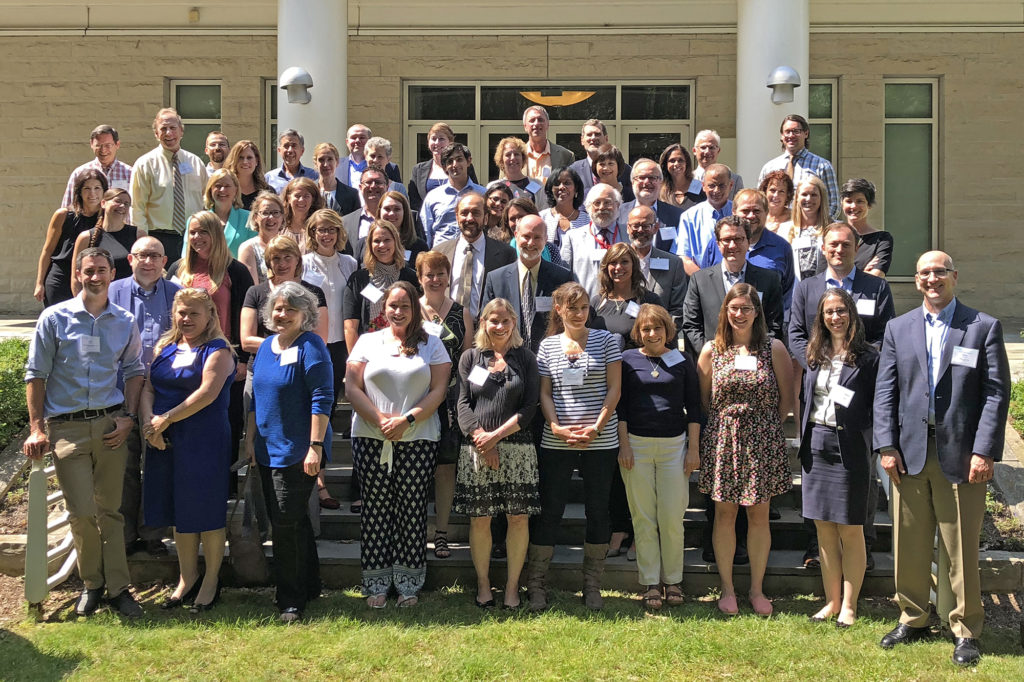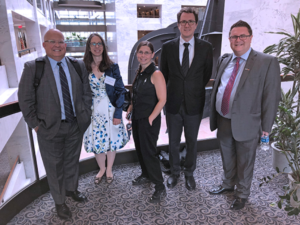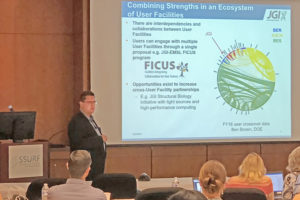Berkeley Lab User Facilities Prominent in SSURF Annual Meeting & Capitol Hill Office Visits.
Like roads, water and energy systems, ports, and other critical infrastructure, scientific user facilities enable the innovation at the heart of U.S. economic competitiveness and national security. The Society for Science at User Research Facilities (SSURF) is a not-for-profit organization working to advance awareness of user science. Under the umbrella of “America’s Evolving Scientific Infrastructure,” SSURF convened its 2018 Annual Meeting at the American Center for Physics, University of Maryland, College Park, June 26-28, 2018.
Paul Runci, Senior Policy Advisor with Pacific Northwest National Laboratory and Chair of the SSURF Board of Directors, kicked off the meeting, which was attended by 65 participants, many of whom represented 25 user facilities that are SSURF members thus far. Individual memberships are welcome as well. The agenda focused on opportunities to build a coherent network of user facilities, users, and supporting agencies, identify relevant metrics and mechanisms such as digital object identifiers (DOIs) to track impact, and ORCID unique identifiers to track users, and effective ways to capture the success stories of the users and facilities and convey them to stakeholders.
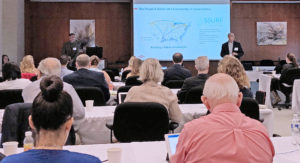
Brian Landes, Technology Leader, Dow Chemical (left) and PNNL’s Paul Runci, Chair of the SSURF Board of Directors.
Representatives from Berkeley Lab’s five user facilities were in attendance: Susan Bailey and Andrea Jones of the Advanced Light Source (ALS); Lauren Rotman of the Energy Sciences Network (ESnet); Nigel Mouncey and David Gilbert of the Joint Genome Institute (JGI); Alison Hatt of The Molecular Foundry; and, Richard Gerber and David Skinner of the National Energy Research Scientific Computing Center (NERSC). Also present was Francesca Toma of the Joint Center for Artificial Photosynthesis (JCAP).
JGI Director Nigel Mouncey presented,“How Facilities Can Partner with Industry to Strengthen the Scientific Infrastructure.” Alison Hatt, who also serves on the SSURF Board of Directors, moderated a session entitled, “Engaging User Groups to Enhance Facility Ties and Communication.”
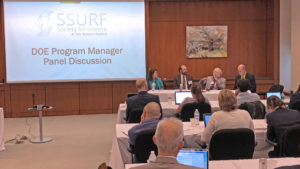
ASCR’s Laura Biven, with BES’s George Maracas and BER’s Dan Drell and Paul Bayer, describe how their programs and the facilities they manage have responded to the shifting landscape of how science is performed.
Laura Biven of the Advanced Scientific Computing Research (ASCR) program convened a panel that included JGI’s Program Manager Daniel Drell and the Environmental Molecular Sciences Laboratory (EMSL) Program Manager, Paul Bayer, from the DOE Office of Biological and Environmental Research, and George Maracas of the Office of Basic Energy Sciences, who oversees the Nanoscale Science Research Centers. The panelists contributed their observations about the shifting landscape of how science is performed and how their programs and the facilities they manage have responded.
On Thursday, June 28, after several dry runs with feedback provided by Capitol Hill frequenters, selected participants took their stories to Congress with the goal of raising awareness of the enabling role that national user facilities play in support of the nation’s research infrastructure. Don Medley, Berkeley Lab Head of Government and Community Relations, coordinated the visit and led one of the groups which included JGI’s Nigel Mouncey, JCAP’s Francesca Toma, Jen Bohon of Case Western University (a user of the National Synchrotron Light Source II at Brookhaven National Laboratory), and Nicholas Schwarz of the Advanced Photon Source at Argonne National Laboratory.
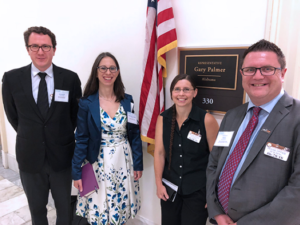
Left to right: SSURF Congressional office visits Team 3 consisted of APS’ Nicholas Schwarz, JCAP’s Francesca Toma, Case Western University’s Jen Bohon, and JGI’s Nigel Mouncey.
The team made a whirlwind tour of Congressional offices, visiting with Senator Mike Rounds (R-SD) and Representative Gary Palmer (R-AL) and with staffers from the offices of Senator John Kennedy (R-LA), Senator Joni Ernst (R-IA), Senator Kamala Harris (D-CA), Representative Bob Gibbs (R-OH), and Representative Marcia Fudge (D-OH).
JGI’s Nigel Mouncey reflected on his first foray into the halls of Congress remarking, “it’s both humbling and energizing to meet with those responsible for setting science policy and funding directions for the nation and representing districts where JGI’s users make a tangible impact. It’s a bit of a challenge to summarize what may amount to be a collaborator’s life work in non-technical language and tell a compelling story that can resonate with a Senator, Representative, or staffer in less than two minutes. But what an amazing opportunity to speak to the value of the National Laboratories and User Facilities in driving the nation’s innovations and how we enable groundbreaking science.”
